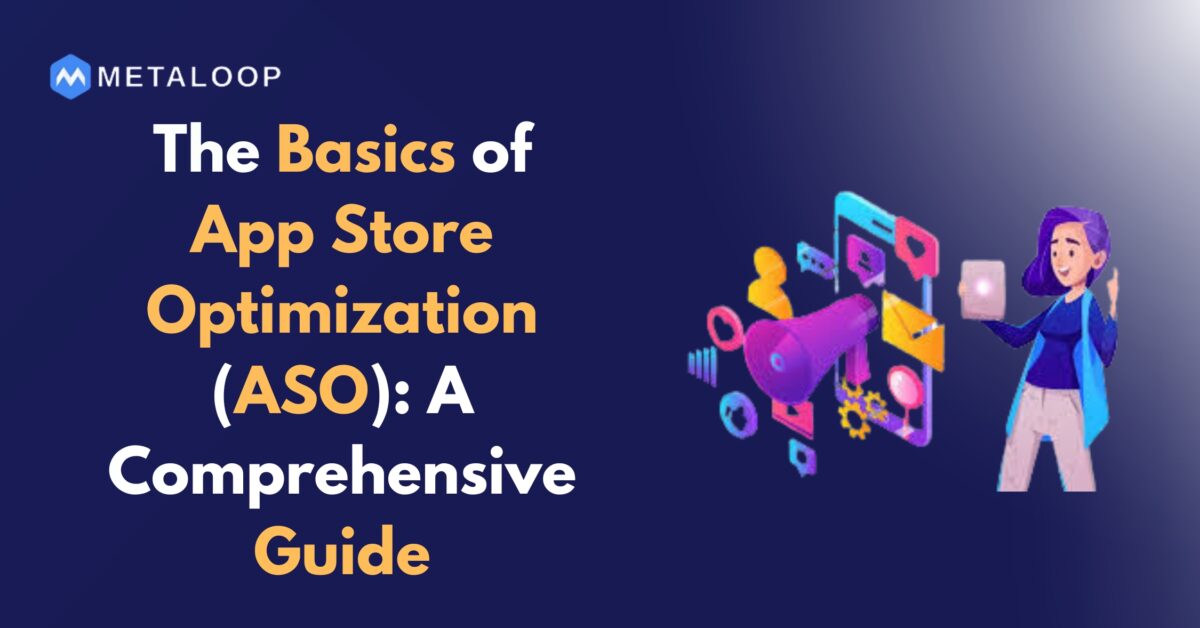The Basics of App Store Optimization: A Comprehensive Guide
You may generate income, interact with users, and raise brand exposure with a mobile app. Getting your app noticed is one of the biggest problems confronting mobile app publishers today, with more than 6 million mobile apps available in the main app stores. This is why understanding app store optimization (ASO) is so crucial.
But what is app store optimization? What you need to know to improve your app’s ranking is as follows:
What is App Store Optimization?
A strategy for increasing an app’s visibility in an app store is called app store optimization (ASO). Each app is ranked in the app stores using a number of criteria. Utilizing effective keywords, beneficial photos, and localized descriptions can help you rank higher and increase downloads as a result of that visibility.
The purpose of ASO is to boost an app’s download count. However, it may also raise brand exposure, encourage user interaction, and elicit reviews and comments. ASO is a closed-site search engine in reality. Similar to SEO, the proper indexation of websites, discoverable content, and manipulation of the App Store’s ranking algorithms are all essential.
Importance of App Store Optimization
You have control over your app’s exposure and discoverability thanks to ASO in today’s fiercely competitive app marketplaces.
You may engage with a targeted audience and promote your app’s differentiating features through app store optimization. A good ASO may significantly increase installs, which makes it important to app marketers. Additionally, they are organic installations, which frequently prove to be the most beneficial users for a program.
Without app store optimization, the search engine of the app store and a little bit of luck will determine your app’s ranking and exposure.
Ongoing ASO is necessary for your app to be successful in its most important App Store marketing channel.
How to do App Store Optimization
1. Optimize your App Title and Subtitle
The title is our first impression online. You read this post because of it, and consumers will download your app because of it. Including a keyword in the title raises that title’s search ranking by 10.3%!
Naturally, there are certain restrictions because the App Store is so tightly controlled. With only 30 characters available for titles in Apple, filling your title with keywords almost guarantees a ban.
Users are hesitant to download suspicious-looking apps out of worry about their privacy. Consider which app you would like to use on your smartphone: “Evernote” or “Note Taking Note App for Notes”?
Be smart about how you optimize.
2. Write an Engaging App Description
Here’s where things get a bit murky. Technically, the description is disregarded by the App Store algorithm. But users are a very different matter. Focus on describing the advantages and benefits of your product rather than SEO optimization.
Although it appears like you have a lot of room to accomplish this, you don’t. The App Store only displays the first few lines of the description, so it’s crucial to make those count. Grab users’ attention with a concise and compelling introduction that highlights the unique aspects of your app. Remember, users are more likely to download an app that clearly communicates its value in a limited space.
3. Add Keywords
You can input keywords that characterize your software and that you want to appear in the Apple Software Store’s search results in a field provided by the app store. When rating your app, Apple will take these keywords into account.
The number of keywords you may input is up to you, but they must all be 100 characters or less. Commas should be used to separate keywords. This is a place for you to get creative with your keyword research, just like with the name of your app. Additionally, you can use it to routinely test various keyword and phrase combinations to discover which ones perform the best for your app.
Try to strike a balance between common, highly competitive keywords that you’re less likely to rank for and less common keywords that you might rank for but will drive fewer downloads. Even though the same terms are frequently used throughout your keyword study, you shouldn’t duplicate words or phrases because of how Apple crawls and indexes the keywords field.
4. Encouraging App Review and Rating
Customer reviews and ratings are an important consideration for users, especially those unfamiliar with an app brand.
Apps with better ratings also appeared higher on the list. This is a challenging conundrum since you want more ratings and reviews but not if they are unfavourable. You must thus find a means to interact with your users inside your app, offering them a forum for complaining and direct communication with the programmer. On the other hand, you want to motivate pleased clients to recommend you in reviews. The average star rating for the top 100 free apps in the App Store is 4. Evidently, quality counts.
Customers are less likely to consider downloading your product the lower your rating is. Consider this. When did you last download an app with only one star? An app may have received one star from you, but when you downloaded it, it probably had three or more stars.
Ratings have an influence on conversions as well. Maintaining a high rating is usually easier than raising it from two or four stars. This makes it essential to get evaluations from app users.
It only needs to be done once, and it must be done within the first 72 hours. 77% of users will utilize an app for that amount of time before never again turning it on. Additionally, it’s crucial to hold off until the consumer has had an opportunity to utilize the app. Consider using a push notice when the consumer completes specific steps rather than putting it on a timer.
5. Update Regularly
As both the Apple App Store and Google Play employ app freshness and update frequency as ranking indicators, freshness is a crucial component of ASO.
This is because app stores and users alike want to see continually improving and evolving apps.
It doesn’t seem very attractive to use an app that hasn’t been updated in five years, does it?
Updates provide you the chance to fix errors and add new features while also taking into account customer input.
You can use the “What’s New in This Version?” field on Google Play or the “Release Notes” section in the App Store to let people know about your modifications. Add relevant keywords and standout characteristics that consumers might be looking for.
If just for bug fixes, think about upgrading your app once or twice every month.
6. Monitor the Results and keep Testing
You should continuously test new iterations of your app store components and expand on your findings if you want ASO to be effective.
You must know which modifications produce beneficial effects in order to do this.
The data that the app shops give might provide some key insights. The rankings of your software are not tracked by Google Play or the software Store, though.
You can keep track of your keyword ranks, downloads, ratings, reviews, and even revenue using tools like Semrush’s Mobile App Insights.
You can also discover and track which keywords result in the most downloads for your app.
Metrics like these, coupled with those the app stores provide, are invaluable for making decisions about your ASO strategy and implementation.
On iOS, don’t be afraid to experiment with new titles, subtitles, descriptions, and keywords.
Test several snapshot and video formats to discover what motivates improvement.
Continue to adjust your plan of action to evaluate what works and yields the desired outcomes.
Simply remember to record all of your modifications. So if results don’t go as expected, you can always revert to a previous version.
Conclusion
App Store Optimization (ASO) outperforms growth trends and continues to increase. Your ASO efforts should always be adjusted and tracked. The first problem is how to get apps discovered by customers naturally inside the top app shops, even if you come to a point where you’re pleased with the performance of your app store. You may boost your app’s exposure and raise its chances of success in the app stores by consistently putting the ASO strategies mentioned in this article to use.



Write a Comment